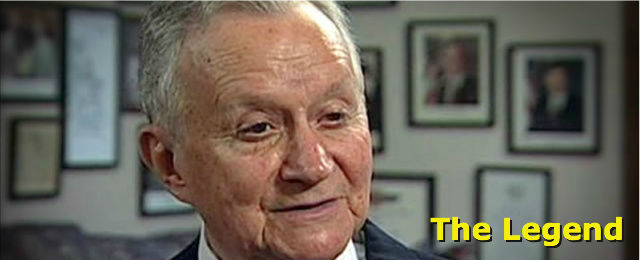Michael Tilley: Hammerschmidt’s Passing A Reminder There Are Some You Can’t Replace
by April 3, 2015 8:24 am 213 views

Editor’s note: This guest opinion column is courtesy of Michael Tilley with The City Wire.
Having watched and interviewed elected officials for more than 30 years, there are only two with which it was easily and immediately evident why they were popular and successful: Bill Clinton and John Paul Hammerschmidt – men who were not similar in backgrounds, personalities or politics.
And I’ve met a few presidential and vice presidential candidates and folks wanting to be a governor or a U.S. Senator. And don’t think me cynical for believing a majority of them are, while maybe well-intended, unqualified folks who merely went to the right schools, came from the right families, had clever talking points, and could afford the good suits.
Not so – except maybe for the good suits – with Clinton or John Paul, as we in the Third District would refer to him with reverence as if he lived at the Vatican.
Former Congressman John Paul Hammerschmidt died Wednesday, April 1. He was 92, and would have been 93 on May 4. If John Paul Hammerschmidt’s life ended in 1966 when he was 42 years old and before he ran for Congress, he’d have had a full life that many don’t record in twice that time. He was a highly decorated pilot during World War II, a successful businessman and before he ran for Congress was broadly and deeply involved in the betterment of Harrison and Boone County, and the industry in which he worked.
And while Clinton brought Arkansas prestige with his Presidential history, I’d argue that Hammerschmidt did more for the state. Billions in federal, state and local money were directed to critical infrastructure projects in the 3rd District – Interstate 49, U.S. 412, Northwest Arkansas Regional Airport, Arkansas River navigable waterway, just to name a few – as a result of his 26 years in Congress.
That tally does not count the millions in tourism dollars from the Buffalo National River. The relatively new Hammerschmidt had everything against him when in the late 1960s and early 1970s he decided to stop the federal government from building dams on what is now one of the top river tourism destinations in the country. No one had ever thought to incorporate a river into the national park system, and Republicans weren’t supposed to be friends of the environment. But he quietly gathered support, sought wise counsel and presented facts – a method that became his trademark – and in 1972 the 135 miles of the Buffalo River became the first river included in the National Park System.
But maybe the key thing to know about Hammerschmidt is that he would not like my subjective point about him doing more than Clinton. He would say such comparisons aren’t productive, or that they open doors to unnecessary conflict. He’d note with that easy smile and always-calm tone that your opponent of today may be your ally tomorrow.
I first learned from Miss Ada Mills that the key to political success was pressure and time; if it’s important, keep applying pressure in a respectful but forceful manner until you wear a hole in someone’s resolve. Hammerschmidt was a master of pressure and time. He worked within the system. He respected the players, even when the politics of Watergate, energy crises, war and recession created deep divides. He didn’t send letters to foreign leaders complaining about the White House occupant.
Back to the point, Hammerschmidt would have questioned the necessity of my previous sentence. During a September 2011 ceremony in which Hammerschmidt’s Congressional papers were opened by the University of Arkansas library, former U.S. Sen. David Pryor, a Democrat, said he never once heard Hammerschmidt “disparage the name or motive” of a political opponent.
By the way, the documents Hammerschmidt collected during his more than 25 years in Congress were delivered in more than 1,500 banker boxes and took UA library workers more than six years to organize and index — and the index is contained in two large books that total 904 pages.
Just a short list of his appointments and political jobs provides an idea as to how respected he was by leaders in both parties. In 1974 he was appointed to the Select Committee on Aging. In 1977 he was chosen as a delegate to the Middle East Peace Talks. In 1984 he served as a delegate on the first post-Vietnam War “official” party to Hanoi. In 1989 he was appointed to the President’s Commission on Aviation Security and Terrorism, which was sent to investigate the terrorist bombing of Pan Am Flight 103 over Lockerbie, Scotland. After retiring from Congress in 1993, he served as honorary chairman of the Dole/Kemp campaign in 1996 and in 1998 was appointed by then-President Bill Clinton to the Metropolitan Airports Authority Board of Review.
It’s possible that many of us in Arkansas were (or are) ignorant of his deep influence in Washington. I certainly was.
In the early 1990s I had the chance to be one of four D.C. interns for Hammerschmidt. During a lunch with several interns, a veteran staffer quizzed us about the member of Congress we were with.
As the interns spoke in order around the table, they would mention the big names like Kennedy, Moynihan, Hyde and so on.
When I said, “Hammerschmidt,” I was proud to do so but expected little in the way of response. Instead, this staffer began peppering me with questions about Hammerschmidt. Even as dense as I can be, it soon became clear the veteran staffer who knew how things got done on Capitol Hill respected Hammerschmidt more than the big names.
We’ve lost a great man, and I fear we’ve lost the political environment in which he was able to do great things.
